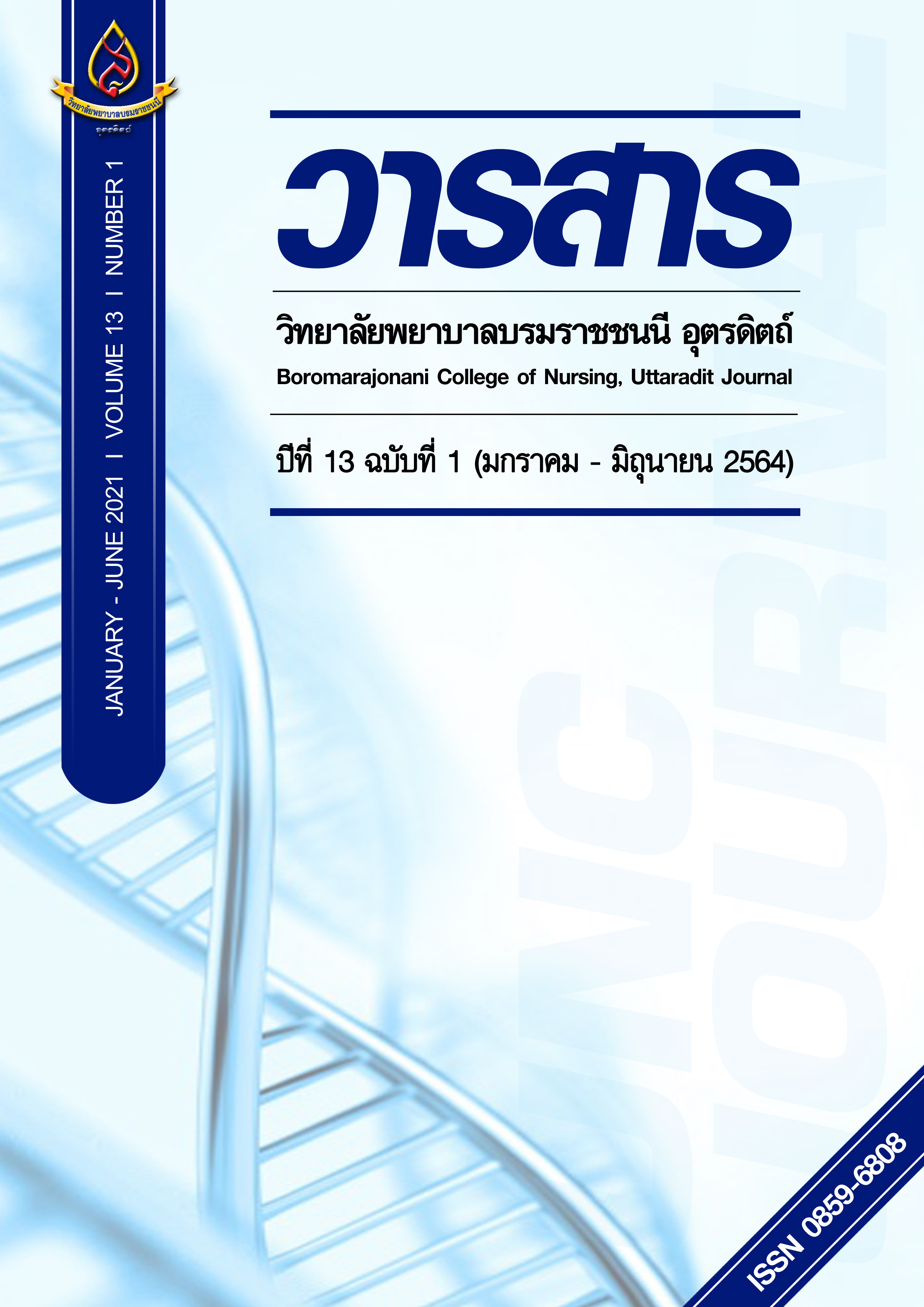การดูแลผู้เป็นเบาหวาน: บทบาทของพยาบาลในสถานการณ์การระบาดของโควิด 19
Main Article Content
บทคัดย่อ
การแพร่กระจายเชื้อโควิด 19 เป็นไปอย่างรุนแรงและรวดเร็วส่งผลกระทบทั่วโลก โดยเฉพาะกลุ่มผู้เป็นเบาหวานที่เป็นผู้ป่วยเรื้อรังกลุ่มใหญ่ของโลก ทำให้ผู้เป็นเบาหวานมีปัญหาการเข้าถึงระบบบริการสุขภาพ ส่งผลให้เสี่ยงต่อการเกิดภาวะแทรกซ้อนที่รุนแรงและอัตราการเสียชีวิตเพิ่มขึ้น บทความวิชาการนี้มีวัตถุประสงค์เพื่อทบทวนความรู้เกี่ยวกับโควิด 19 พยาธิสรีรวิทยา ผลกระทบของโควิดกับเบาหวาน บทบาทของพยาบาลและทบทวนแนวทางการพยาบาลผู้เป็นเบาหวานในยุค New Normal
Article Details
บทความหรือข้อคิดเห็นใดใดที่ปรากฏในวารสารวิจัยการพยาบาลและวิทยาศาสตร์สุขภาพ เป็นวรรณกรรมของผู้เขียน ซึ่งบรรณาธิการหรือสมาคมศิษย์เก่า ไม่จำเป็นต้องเห็นด้วย และบทความที่ได้รับการตีพิมพ์เผยแพร่ถือเป็นลิขสิทธิ์ของวารสารวิจัยการพยาบาลและวิทยาศาสตร์สุขภาพ
เอกสารอ้างอิง
Azami, G, Soh, K.L., Sazlina, S.G., Salmiah, S., Aazami, S., Mozafari, M. & Taghinejad, H. (2018). Effect of a nurse-Led diabetes self-Management education program on glycosylated hemoglobin among adults with type 2 diabetes. Journal of Diabetes Research, Article ID 4930157. https://doi.org/10.1155/2018/4930157
Brufsky, A. (2020). Hypecerglymia, Hydroxychloroquine, and the COVID-19 pandemic. Journal of Medical Virology, 92(7), 770–775.
Cariou, B, Hadjadj, S, Wargny, M, Pichelin, M., Al-Salameh,A., Allix,I... Gourdy, P. (2020). Phenotypic characteristics and prognosis of inpatients with COVID-19 and diabetes: the CORONADO study. Diabetologia, 63,1500–1515. doi: 10.1007/s00125-020-05180-x..
Cox, E. (2020). World Diabetes Day 2020: nursing education and care. Retrieved .(2020, November 12). from
Chen, SC., Lai, YH., & Tsay, SL. (2020). Nursing perspectives on the impacts of COVID-19.Journal of Nursing Research, 28(3), e85. doi: 10.1097/jnr.0000000000000389
Delgado-Roche, L. & Mesta, F. (2020). Oxidative stress as key player in severe acute respiratory syndrome coronavirus (SARS-CoV) infection. Archives of Medical Research, 51(5), 384–387.
Department of Desease Control. (2021). Coronavirus Disease Situation Report 2019. Retrieved (2021, May 8) from: https://ddc.moph.go.th/viralpneumonia/file/situation/situation-no491-080564.pdf (in Thai).
Department of Mental Health. (2020). Combat 4th wave of COVID-19: C4. Bangkok: A1 Printing. (in Thai).
Elnaem, M. H., & Cheema, E. (2021). Caring for patients with diabetes during COVID-19 pandemic: Important considerations for pharmacists. Research in Social & Administrative Pharmacy. Research in Social and Administrative Pharmacy, 17(1), 1938–1941.
Faghir-Gangi, M., Moameri, H, Abdolmohamadi, N, & Nematollahi SH. (2020). The prevalence of type 2 diabetes in patients with COVID 19: a systematic review and meta-analysis. Via Medica, 9(5), 271–278.
Flores-Luevano, S., Pacheco, M., Shokar, G. S., Dwivedi, A. K., & Shokar, N. K. (2020). Impact of a culturally tailored diabetes education and empowerment program in a Mexican American population along the US/Mexico border: a pragmatic study. Journal of clinical medicine research, 12(8), 517–529. doi.org/10.14740/jocmr4273
Garg, S., & Norman, G. J. (2021). Impact of COVID-19 on health economics and technology of diabetes care: use cases of real-time continuous glucose monitoring to transform health care during a global pandemic. Diabetes Technology & Therapeutics, 23(S1), S15–S20. https://doi.org/10.1089/dia.2020.0656.
Hyun, KS, Kim, KM, & Jang, SH. (2009). The effects of tailored diabetes education on blood glucose control and self-care. Journal of Korean Academy of Nursing, 39(5),720- 730. Korean. doi: 10.4040/jkan.2009.39.5.720. PMID: 19901502.
Joint statement by ILO, FAO, IFAD and WHO. (2020). Impact of COVID-19 on people's livelihoods, their health and our food systems. Retrieved (2020, October 13) from https://www.who.int/news/item/13-10-2020-impact-of-covid-19-on-people's livelihoods-their-health-and-our-food-systems#:~:text=The%20economic% 20and%20social%20disruption,the%20end%20of%20the%20year
Lacobellis, G. (2020). COVID-19 and diabetes: can DPP4 inhibition play a role? Diabetes Research and Clinical Practice, 162,108125. doi: 10.1016/j.diabres.2020.108125.
Lea-Henry T.N., Baird-Gunning J., Petzel E.,& Roberts D.M. (2017). Medication management on sick days. Australian Prescriber, 40(5), 168–173. doi: 10.18773/austprescr.2017.057.
Lim, S., Bae, J.H., Kwon, HS. , Nauck.MA. (2021). COVID-19 and diabetes mellitus: from pathophysiology to clinical management. Nature Reviews Endocrinology, 17, 11– 30 doi.org/10.1038/s41574-020-00435-4
Muralidharan, S., Ranjani, H., Anjana, R. M., Allender, S., & Mohan, V. (2017). Mobile health technology in the prevention and management of type 2 diabetes. Indian Journal of Endocrinology and Metabolism, 21(2), 334–340.
doi.org/10.4103/ijem.IJEM_407_16
Nerpin, E., Toft, E., Fischier, J., Lindholm-Olinder, A., & Leksell, J. (2020). A virtual clinic for the management of diabetes-type 1: study protocol for a randomised wait-list controlled clinical trial. BMC Endocrine Disorder, 20, 137 doi.org/10.1186/s12902-020-00615-3.
Nikitara, M., Constantinou, C. S., Andreou, E., & Diomidous, M. (2019). The role of nurses and the facilitators and Barriers in diabetes care: a mixed methods systematic literature review. Behavioral sciences (Basel, Switzerland), 9(6), 61. doi.org/10.3390/bs9060061.
Orioli, L., Hermans, MP., Thissen, JP., Maiter, D., Vandeleene, B., & Yombi, JC. (2020).COVID-19 in diabetic patients:
Related risks and specifics of management. Annales d’Endocrinologie (Paris), 81(2-3),101-109. doi: 10.1016/j.ando.2020.05.001. PMID: 32413342; PMCID: PMC7217100.
Papachristou, S., Stamatiou,I., Stoian, A.P.,& Papanas, N. (2021). New-onset diabetes in COVID-19: time to frame its fearful symmetry. Diabetes Therapy, 12(2), 461–464. doi: 10.1007/s13300-020-00988-7.
Reddy PK, Kuchay MS, Mehta Y, Mishra SK. (2020). Diabetic ketoacidosis precipitated by COVID-19: a report of two cases and review of literature. Diabetes Metabolic Syndrome, 14,1459–1462. doi: 10.1016/j.dsx.2020.07.050.
Saqib, M., Siddiqui, S., Qasim, M., Jamil, M. A., Rafique, I., Awan, U. A., Ahmad, H., & Afzal, M. S. (2020). Effect of COVID-19 lockdown on patients with chronic diseases. Diabetes & Metabolic Syndrome, 14(6), 1621–1623.
https://doi.org/10.1016/j.dsx.2020.08.028
Shi Q, ZX., Jiang, F., Zhang, X., Hu, N., Bimu, C., Feng, J...Wang, W. (2020). Clinical characteristics and risk factors for mortality of COVID-19 patients with diabetes in Wuhan, China: a two-center, retrospective study. Diabetes Care, 43(7), 1382-1391. doi: 10.2337/dc20-0598. Epub 2020 May 14. PMID: 32409504.
Singh, AK, & Singh, R. (2020). Hyperglycemia without diabetes and new-onset diabetes are both associated with poorer outcomes in COVID-19. Diabetes Research and Clinical Practice, 167, 108382. doi: 10.1016/j.diabres.2020.108382.
WHO. (2021). Diabetes. Retrieved (2021, April 13) from https://www.who.int/news- room/fact-sheets/detail/diabetes
Wicaksana, A.L., Hertanti, N. S., Ferdiana, A., & Pramono, R. B. (2020). Diabetes management and specific considerations for patients with diabetes during coronavirus diseases pandemic: a scoping review. Diabetes & metabolic syndrome, 14(5), 1109–1120. https://doi.org/10.1016/j.dsx.2020.06.070
Wu, Z. & McGoogan, J. M. (2020).Characteristics of and important lessons from the coronavirus disease 2019 (COVID-19) outbreak in China: summary of a report of 72314 cases from the Chinese Center for Disease Control and Prevention. The Journal of the American Medical Association,323, 1239–1242.
Yaribeygi,H, Sathyapalan, T., Jamialahmadi, T., & Sahebkar, A (2020). The impact of diabetes mellitus in COVID-19: a mechanistic review of molecular interactions. Journal of Diabetes Research, ID 5436832, https://doi.org/10.1155/2020/5436832


